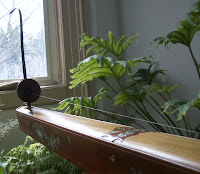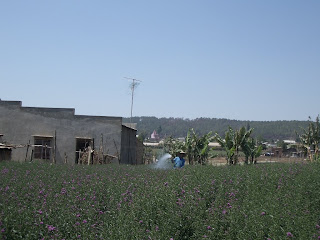
Tourism, as I witnessed it, was rarely advantageous to the people in the direct vicinity of it. At it’s best, it made a little money for the postcard seller, the moto driver, the roadside marketeer, and a few others. But it changed people, and made them run someone else’s game. When most native people eyed a tourist, their main goal was to try to get some of the disproportionately strong money that these intruders brought in. Spectators were fair game, and the natives would not stop until they felled their prey, for they were skilled hunters. Who can blame a people whose yearly income probably compares to our weekly income, and who could never even dream of leaving their own country to taste the exotic fruits, to hear the enticing sounds, to sense the peculiar feelings of a foreign country?
While rebuffing attempts at a guilt trip to my wallet by an enterprising moto driver, I also knew he was right in telling me how lucky I was that I could leave my country. He really was poor and needed to feed his children with whatever money I could give him. To be a traveler involves a tough skinned coldness combined with a savvy, clever but benevolent demeanor. When to give a little more than necessary for the job done, when just to give, and when to stand your ground and get the best price. Sometimes you find a friend after the money is exchanged, sometimes you find you have just been swindled. But you have to realize the grand swindler is no one but yourself. On this “trip on a shoestring”, this in a land where many don’t even have shoestrings to speak of.
The dollar, in whatever form it takes, is, after all, the fruit that most people around the world collect for sustenance. It seems logical then that it would weigh so heavily on people’s minds and play such an important role in people’s interactions. To expect anything different while traveling would be to insult the intelligence of the people there. It’s not easy to keep this in mind when a lady wants 40,000 dong for a pastry and you know the real price is 2000. Along with being a little transparent and grabby, she is really just a product of the clumsy interaction between those who have and those who have not. I would complain of the lack of respect for the fellow human sometimes when I was being overcharged on a regular basis- no one likes to be fooled or coerced into paying more than they should. But again, the real trickery is done by us who think we can waltz into another land as a spectator to a great show for a great deal.
There were plenty of places where this interaction and it’s effects were rotting the vibrant and fragile culture around it. Because of this, I wanted nothing to do with the intruders, but could do nothing to avoid the fact that I was one myself. There were times when this disease was transcended and for brief moments, knowledge and feelings were exchanged or given. Beautiful moments sometimes cloaked in the dirty, smelly, blood soaked surroundings of a destroyed
land. Sometimes hidden in the nacient attitude of a people and country just now allowed to take their own course. Sometimes their humor and benevolence would surprise you and make you marvel at their fortitude. At the very least you got a glimpse into what it is that makes people tick, because when it came down to it, it wasn’t money, cause there wasn’t enough of that to go around. It was something else, and I’ve seen it.
I marveled at times like the one when I walked the back streets of Pnom Phen. It was crowded, and some houses were made only of plywood and cardboard. People stared from their houses as I went by, and I had enough money in my pocket to feed everybody on that street for a month probably. And they knew it, but not one malicious stare. The tales of guns and debauchery, of theft and villians couldn’t be reconciled with the respectful nods and acceptance of me being there. Or the kind and precious look from a girl as she passed by me on a moto. We saw each other’s eyes, eyes from across the world, eyes we will never see again. Or the moto driver who found me, but didn’t want to take me anywhere, didn’t want my money. He wanted to buy me a meal at his favorite restaurant if I would only talk english with him for a while. He taught me that you have to put one teaspoon of sugar in your Cambodian soup, he told me that he couldn’t kill any living thing because of his commitment to Buddha. I paid of course and was the richer for it. Or the tour of the S-21 khmer rouge prison, where I was told of the horrific history of the Khmer people, what they had to endure from Pol Pot. And the testimony of nearly every adult that they had lost their parents or close relatives to Pol Pot. After saying this, the next thing out of their mouth would often be about me. They had had enough thought and suffering, they wanted to live on, make me laugh, find out about me. Or the trip on a flat boat down a flooded and lazy river when we picked up a stranded older lady who probably never had any reason to venture outside of her town. Her youthful and assuring smile told me she lived a happy life, and she shared her fruit with us as payment for the ride. And the amusement the owners of a roadside restaurant got at watching me eat their house specialty, roasted dog with extremely strong rice wine. And finding out from a bunch of 20 something guys in Hanoi that women there give them the same headaches and pleasures as they do back at home. And watching old men socialize at their favorite coffee shop while downing one of the best drinks on earth, a creamy vietnamese coffee. And a woman poking her tongue out at me in jest out of a passing crowd of bikers all dressed in white flowing dresses, making me love her spontaneity and soul. And the enthralled group of young kids who encircled me on a beach, making fun of my hairy skin and amazed to see a white man in their out of the way town. And the many discussions I had with ex-soldiers, their stories painting a picture never told in my country. Stories of lives lost, destroyed and risked for different governments, conflicting ideals. And the stories telling the point of view of somebody fighting for the mere sovereignty of their country.
How refreshing it was to never feel real aggression from anyone, even in an argument. I now see why they are leary of us back at home. Learning that guns and murders were extremely rare phenomenon in these countries. Physical harm wasn’t the only threat to get things done there, it was cleverness and wits. And the 40 hour train-bus-train ride that was supposed to be a 19 hour train ride. Realizing that patience was a way of life for that crowd that day, and that I better learn it quick since it might be 8 hours till the flood waters recede enough to go on. All these were things, if my intentions were humble and true, that I could learn from. It was possible I could be more than a tourist, someone who was in the same game as the native people, going in some way through the same thing. So when I decided to take the road down into the H’mong village, I was hesitant, I didn’t want to just trapse through, staring at “different people”.















